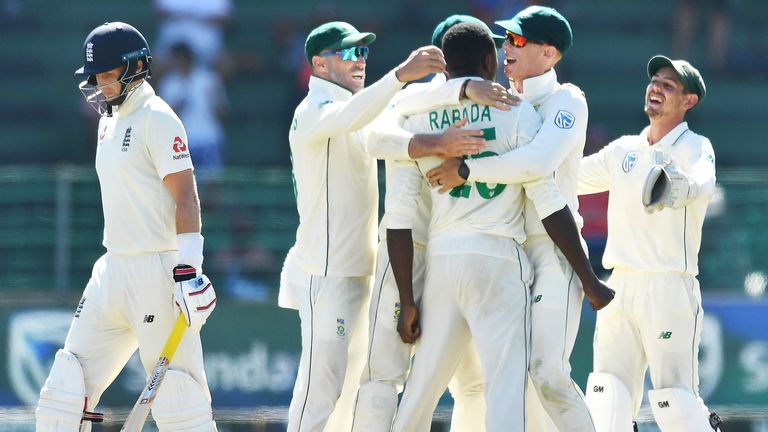England’s Test series whitewash is a reflection of New Zealand’s waning bowling powers, rather than their much-hyped batting. The Proteas bowling attack is better equipped to reopen England’s batting wounds, writes RYAN VREDE.
On Monday, England secured a 3-0 series win over the reigning Test world champions. It arrested a slide during which they lost 1-0 to New Zealand, 4-0 to Australia and 1-0 to the West Indies (they also trail India 2-1 in a home Test series, with the rescheduled fifth Test starting on Friday).
England’s dominance over the past month was built on excellent and often brutal batting. A tweet from BBC commentator Daniel Norcross underlined this dominance: “New Zealand took 222.5 overs to score 657 in [the third Test]. England won it in just 121.2. Preposterous.”
In the last three innings of the series, England scored at 5.98, 5.37 and 5.44 per over. This represented three of the fastest run rates in any Test innings of 50 overs or more.
Many are hailing the dawn of an era under newly appointed coach Brendon McCullum and skipper Ben Stokes. However, any such appraisal needs to be tempered with the consideration that this Black Caps bowling lineup is, at best, recalibrating and, at worst, one whose potency has completely faded. I suspect it’s the latter.
Since winning the World Test Championship final last year, New Zealand have won two Tests, drawn one and lost six. Most of their problems have been rooted in their struggle to take wickets.
It didn’t surprise me that England bossed this facet of the game. This is a New Zealand side with a 33-year-old Tim Southee, Trent Boult mere days from turning 33, Ajaz Patel who is touching 34, a nearly 36-year-old Colin de Grandhomme, and a nearly 37-year-old Neil Wagner. This compromised change bowlers Kyle Jamieson and Matt Henry, who rarely had a platform to attack from, as they did in 2021. Their bowling attack was completed by Michael Bracewell, who debuted in the series.
Of the 60 wickets available to them, they took 43, and conceded between 250 and 300 thrice, over 350 once and over 500 once. In three consecutive Tests, they had to defend 277, 299 and 296, hardly low scores, but failed dismally in this assignment.
This Black Caps attack is a shadow of the unit that earned them the Test crown. Their time is done.
They were not equipped to put England’s batsmen under pressure for any meaningful period of play. And, in recent history, pressure has exposed the fragility of this England lineup.
Last year India bowled them out for under 200 six times in eight innings and, in one of those, they managed only 205. In the 2021 series against New Zealand, they collapsed for 122, in just 42 overs, in the second innings in Birmingham against New Zealand, losing the series.
They then crumbled under pressure in the fourth Test against India in September 2021, relinquishing a commanding position and being asked to chase 368 for victory. They were rolled for just 210.
In the 2021-22 series against Australia, they were shot out for under 200 in six of 10 innings.
When it counted in the third and deciding Test against the West Indies in St George’s earlier this year, they folded for 120 against the right-arm medium pacers of Kyle Myers, giving the Windies 28 to chase for victory.
This brings us to the three-Test series between South Africa and England that starts in mid-August. I’ve read the opinion that warns of the incredible challenge South Africa’s bowlers will face against this “fearless” England batting lineup. I don’t share those concerns.
England must be respected, but their feats against a toothless New Zealand attack must be tempered with the perspective that Kagiso Rabada, Anrich Nortje, Lungi Ngidi, Marco Jansen, Simon Harmer and Keshav Maharaj are a superior collective, possessing a range of qualities their Black Caps counterparts simply can’t match.
England have openers who are new to Test cricket, a No 3 in Ollie Pope who averaged 28 prior to the New Zealand series (after 40 innings), and a lower middle order that doesn’t have the imposing presence it once did.
Joe Root and Ben Stokes are world-class players, but Jonny Bairstow has a performance history of high peaks and deep valleys. He was breathtaking against New Zealand and averages 50 against the Proteas, but he doesn’t pose the same threat as Root.
England in England has been and most likely will always be a stern test of any elite Test side. South Africa’s bowlers will have to operate at extremely high levels across the three-Test series to rip off the band aid that covers the wounds afflicted prior to England’s series against New Zealand. They have the competency to do this.
And when you consider the impressive strides the Proteas batting unit has made against elite opposition, it sets up an intriguing series.







